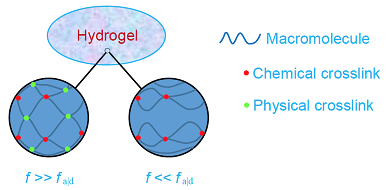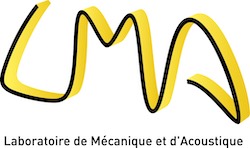Doubly cross-linked, single network hydrogels embody both chemical and physical cross-links. Chemical cross-links are covalent bonds while the physical cross-links may include hydrogen bonds, hydrophobic interactions, p–p interactions, van der Waals interactions and ionic interactions ; that is, ion–ion, ion–dipole and dipole–dipole interactions. Only the chemical cross-links are active at very low frequencies while both chemical and physical cross-links are active at higher frequencies, see Figure 1.
 Figure 1 : Doubly cross-linked, single network hydrogel excited at high and low frequencies
Figure 1 : Doubly cross-linked, single network hydrogel excited at high and low frequencies
The bonding and de-bonding activities of the physical cross-links are at their highest at frequency fa|d resulting in a maximum loss modulus. A four parameter shear modulus model is presented, displaying an almost clean and constant elastic contribution from the chemical cross-links with an added minor overlaid Rouse kind, half fractional-order frequency contribution to the chemical storage and to the chemical loss modulus. The physical cross-links show a Rouse kind, half fractional-order frequency influence to the physical storage modulus and to the physical loss modulus in the low frequency range, display a fast frequency increase of the physical storage modulus in the medium frequency range where the physical loss modulus shows a peak and, lastly, display a high, plateau like physical storage modulus in the high frequency range while the physical loss modulus decreases with frequency. The shear model results and those of the measurements match very well. Various mechanical components made of this tough hydrogel are modeled in the presentation while using the shear modulus model including vibration isolators and dynamic vibration absorbers.


